Related Research Articles
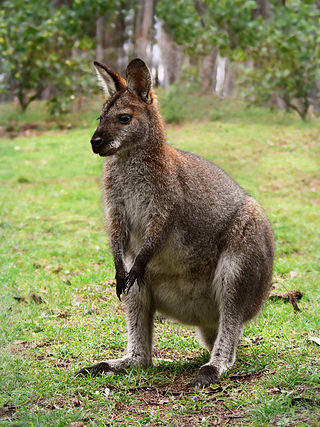
A wallaby is a small or middle-sized macropod native to Australia and New Guinea, with introduced populations in New Zealand, Hawaii, the United Kingdom and other countries. They belong to the same taxonomic family as kangaroos and sometimes the same genus, but kangaroos are specifically categorised into the four largest species of the family. The term "wallaby" is an informal designation generally used for any macropod that is smaller than a kangaroo or a wallaroo that has not been designated otherwise.

The Hawaiian crow or ʻalalā is a species of bird in the crow family, Corvidae, that is currently extinct in the wild, though reintroduction programs are underway. It is about the size of the carrion crow at 48–50 cm (19–20 in) in length, but with more rounded wings and a much thicker bill. It has soft, brownish-black plumage and long, bristly throat feathers; the feet, legs, and bill are black. Today, the Hawaiian crow is considered the most endangered of the family Corvidae. They are recorded to have lived up to 18 years in the wild, and 28 years in captivity. Some Native Hawaiians consider the Hawaiian crow an ʻaumakua.

The regent honeyeater is a critically endangered bird endemic to southeastern Australia. It is commonly considered a flagship species within its range, with the efforts going into its conservation having positive effects on many other species that share its habitat. Recent genetic research suggests it is closely related to the wattlebirds.

Taronga Zoo is a government-run public zoo located in Sydney, New South Wales, Australia, in the suburb of Mosman, on the shores of Sydney Harbour. The opening hours are between 9:30 a.m. to 4:30 p.m. Taronga is an Aboriginal word meaning "beautiful view".

The Hawaiian monk seal is an endangered species of earless seal in the family Phocidae that is endemic to the Hawaiian Islands.

The bridled nail-tail wallaby, also known as the bridled nail-tailed wallaby, bridled nailtail wallaby, bridled wallaby, merrin, and flashjack, is a vulnerable species of macropod. It is a small wallaby found in three isolated areas in Queensland, Australia, and whose population is declining. In early 2019 the total population of the species was estimated to be fewer than 500 mature individuals in the wild and 2285 in captivity.

Monk seals are earless seals of the tribe Monachini. They are the only earless seals found in tropical climates. The two genera of monk seals, Monachus and Neomonachus, comprise three species: the Mediterranean monk seal, Monachus monachus; the Hawaiian monk seal, Neomonachus schauinslandi; and the Caribbean monk seal, Neomonachus tropicalis, which became extinct in the 20th century. The two surviving species are now rare and in imminent danger of extinction. All three monk seal species were classified in genus Monachus until 2014, when the Caribbean and Hawaiian species were placed into a new genus, Neomonachus.
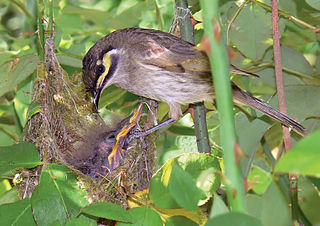
In oviparous biology, a hatchling is a newly hatched fish, amphibian, reptile, or bird. A group of mammals called monotremes lay eggs, and their young are hatchlings as well.

The green sea turtle, also known as the green turtle, black (sea) turtle or Pacific green turtle, is a species of large sea turtle of the family Cheloniidae. It is the only species in the genus Chelonia. Its range extends throughout tropical and subtropical seas around the world, with two distinct populations in the Atlantic and Pacific Oceans, but it is also found in the Indian Ocean. The common name refers to the usually green fat found beneath its carapace, not to the color of its carapace, which is olive to black.

The Mona ground iguana is a critically endangered species of rock iguana, endemic to Mona Island, Puerto Rico. It is one of the island nation's few large land animals, and it is the largest endemic terrestrial lizard in the country, and one of the biggest rock iguanas within the Antilles. It was previously considered a subspecies of the rhinoceros iguana.

Monarto Safari Park, formerly known as Monarto Zoological Park and Monarto Zoo, is a 1,500-hectare (3,700-acre) open-range zoo located in South Australia administered by the Royal Zoological Society of South Australia. By area, Monarto Safari Park is the largest zoo in Australia. It is located at Monarto, approximately 70 kilometres (43 mi) from Adelaide's centre.

The Jamaican iguana, also known commonly as Colley's iguana, is a large species of lizard in the family Iguanidae. The species is endemic to Jamaica. It is critically endangered, even considered extinct between 1948 and 1990. Once found throughout Jamaica and on the offshore islets Great Goat Island and Little Goat Island, it is now confined to the forests of the Hellshire Hills.
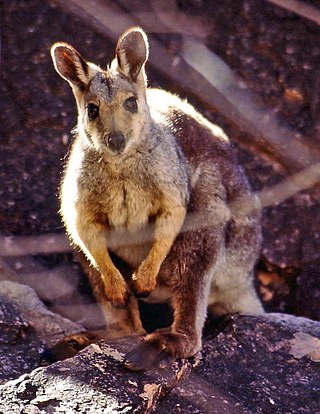
The black-flanked rock-wallaby, also known as the black-footed rock-wallaby or warru, is a species of wallaby, one of several rock-wallabies in the genus Petrogale. A shy, nocturnal herbivore, its two main subspecies are found in mostly isolated populations across western and southern Western Australia (WA), the Northern Territory and parts of South Australia (SA). With some subspecies showing a decline in populations in recent years, the whole species is classed as an endangered species under the Commonwealth EPBC Act.
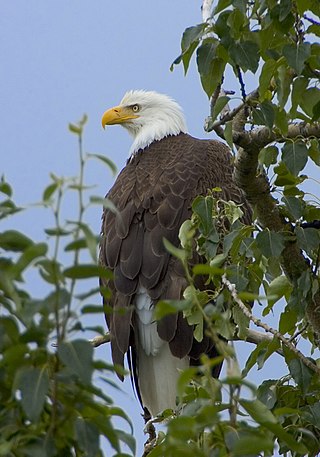
The fauna of the United States of America is all the animals living in the Continental United States and its surrounding seas and islands, the Hawaiian Archipelago, Alaska in the Arctic, and several island-territories in the Pacific and in the Caribbean. The U.S. has many endemic species found nowhere else on Earth. With most of the North American continent, the U.S. lies in the Nearctic, Neotropic, and Oceanic faunistic realms, and shares a great deal of its flora and fauna with the rest of the American supercontinent.

Cyclura is a genus of lizards in the family Iguanidae. Member species of this genus are commonly known as "cycluras" and only occur on islands in the West Indies. Rock iguanas have a high degree of endemism, with a single species or subspecies originating on an individual island.

Cyclura pinguis, the Anegada rock iguana, Anegada ground iguana or stout iguana, is a critically endangered species of lizard of the genus Cyclura belonging to the family Iguanidae. The species can be found exclusively in the islands of Anegada and Guana. Historically, it inhabited the islands of Puerto Rico and Saint Thomas; however, the animal's original range has been greatly diminished over prehistory.

James Campbell National Wildlife Refuge is a National Wildlife Refuge on the island of Oʻahu, Hawaii. It was established in 1976 to permanently protect an ecologically-intact unit and to provide habitat for native and migratory fauna and native flora. It established critical habitat for Hawaii's four endangered waterbirds, the ʻalae kea, koloa maoli, ʻalae ʻula, and āeʻo and many migratory seabirds, endangered and native plant species, and the endangered Hawaiian monk seal and green sea turtle. It also provides increased wildlife-dependent public uses and flood control within the refuge and the local community.

Sea Life Park Hawaii is a marine mammal park, bird sanctuary and aquarium in Waimānalo near Makapuʻu Point, north of Hanauma Bay on the island of Oahu in Hawaii, United States. The park first opened in 1964, and includes exhibits that let visitors interact with the animals by swimming with dolphins, sea lions, and rays, taking a sea safari in the aquarium, and feeding the sea turtles. The park was acquired in 2008 and is operated by Palace Entertainment, the U.S. subsidiary of Parques Reunidos from Dolphin Discovery, which had acquired it in 2005.
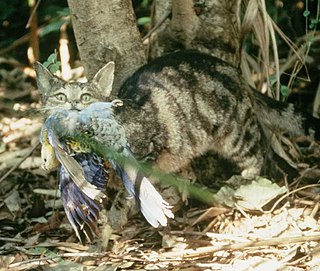
Cat predation on wildlife is the result of the natural instincts and behavior of both feral and owned house cats to hunt small prey, including wildlife. Some people view this as a desirable phenomenon, such as in the case of barn cats and other cats kept for the intended purpose of pest control; but scientific evidence does not support the popular use of cats to control urban rat populations, and ecologists oppose their use for this purpose because of the disproportionate harm they do to native wildlife. As an invasive species and predator, they do considerable ecological damage.
Charles Littnan is an American conservation biologist. He is the divisional director at the National Oceanic and Atmospheric Administration (NOAA) in Hawaii. He works in the Protected Species Division and is the lead scientist in the Hawaiian Monk Seal Research Program.
References
- 1 2 Alberts, Allison; Lemm, Jeffrey; Grant, Tandora; Jackintell, Lori (2004). "Testing the Utility of Headstarting as a Conservation Strategy for West Indian Iguanas". Iguanas: Biology and Conservation. University of California Press. p. 210. ISBN 978-0-520-23854-1.
- 1 2 "Blanding's Turtle Headstart Reintroduction".
- ↑ Perez-Buitrago, Nestor (2005), "Successful Release of Head Start Mona Island Iguanas" (PDF), Iguana Specialist Group Newsletter, 8 (1): 6, archived from the original (PDF) on 2007-08-12
- ↑ Pitches, Adrian (March 2018). "Headstarted Godwits relocate to Portugal". British Birds . 111 (3): 128–129.
- ↑ Gerrodette, Tim; Gilmartin William G (1980). "Demographic consequences of changed pupping and hauling sites of the Hawaiian monk seal" (PDF). Conservation Biology. 4 (4): 423–430. doi:10.1111/j.1523-1739.1990.tb00317.x. JSTOR 2385936.
- ↑ Jurss-Lewis, Tobias (25 May 2021). "Hope for wallabies so endangered they were thought to be extinct". ABC News. Australian Broadcasting Corporation . Retrieved 28 May 2021.